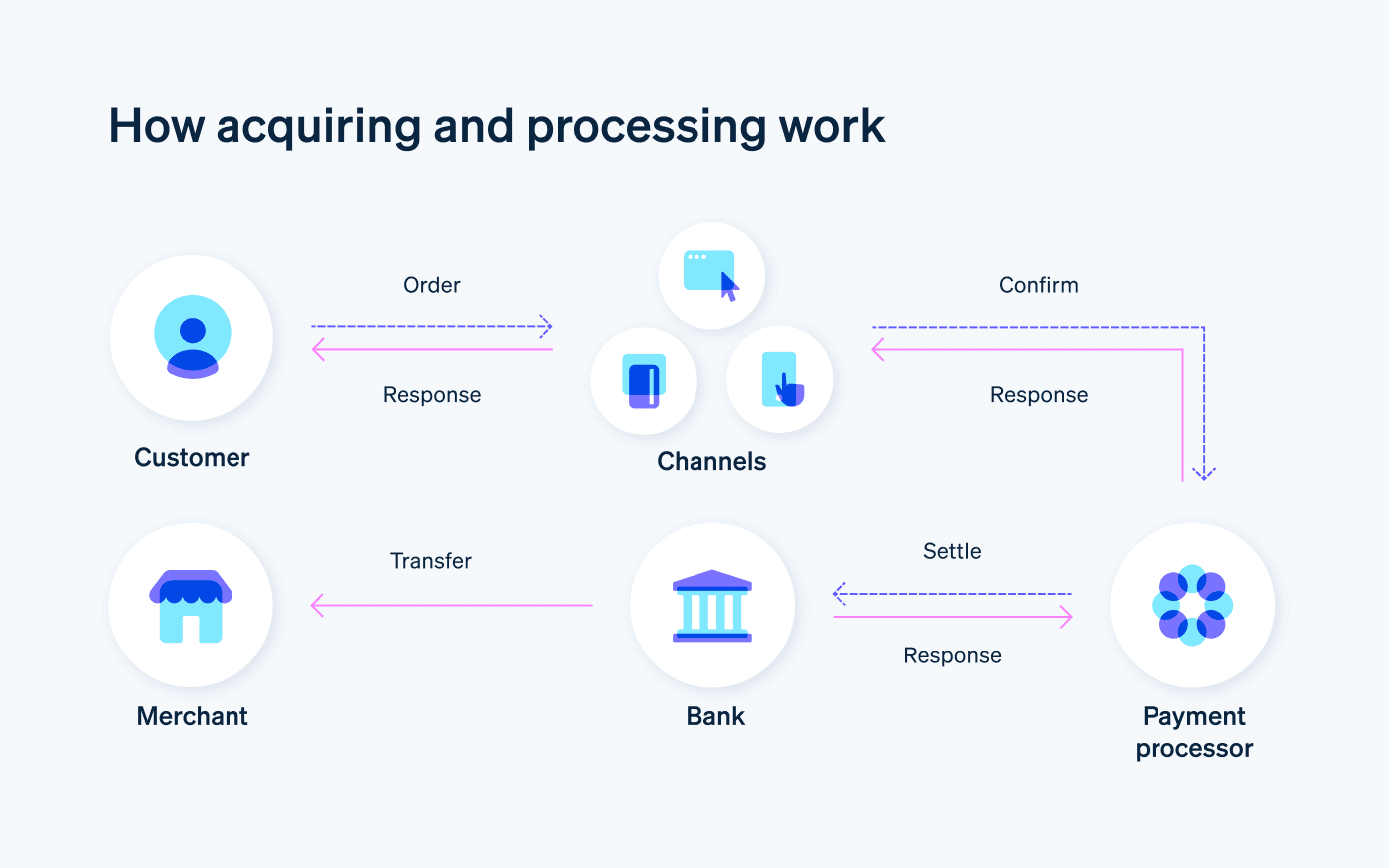โดยเฉลี่ยแล้ว ธุรกิจแบบชําระเงินตามรอบบิลสูญเสียรายได้ 9% จากการชําระเงินที่ไม่สําเร็จ ความสูญเสียเหล่านี้อาจเกิดจากธุรกรรมที่ถูกปฏิเสธ ข้อผิดพลาดในการประมวลผล หรือความไร้ประสิทธิภาพในการกําหนดเส้นทางการชําระเงิน ซึ่งทั้งหมดนี้อาจส่งผลกระทบต่อความสัมพันธ์กับลูกค้า การดําเนินธุรกิจ และรายรับ เพื่ออํานวยความสะดวกในการชําระเงินในทุกช่องทางและปกป้องประสบการณ์ของลูกค้า ธุรกิจต่างๆ จะต้องเข้าใจบทบาทของผู้มีส่วนเกี่ยวข้องหลัก เช่น ผู้ประมวลผลการชําระเงินและสถาบันผู้รับบัตร ซึ่งทํางานร่วมกันเพื่อช่วยให้การชําระเงินแบบดิจิทัลนั้นเกิดขึ้นได้ ความสับสนเกี่ยวกับหน่วยงานเหล่านี้อาจนําไปสู่การตั้งค่าการชําระเงินที่ไม่มีประสิทธิภาพ ค่าธรรมเนียมการประมวลผลที่สูงขึ้น และความเสี่ยงที่เพิ่มขึ้นของธุรกรรมที่ไม่สําเร็จ
ในบทความนี้ เราจะสํารวจผู้ประมวลผลการชําระเงินและสถาบันผู้รับบัตรของผู้ค้า ไม่ว่าจะเป็นความแตกต่าง ฟังก์ชันการทํางานเฉพาะ และการทํางานร่วมกันในกระบวนการชําระเงิน นอกจากนี้ เราจะอธิบายวิธีที่แนวทางการให้บริการชำระเงินแบบครบวงจรของ Stripe ช่วยเพิ่มประสิทธิภาพในการประมวลผลการชำระเงินสำหรับธุรกิจต่างๆ
บทความนี้ให้ข้อมูลอะไรบ้าง
- ผู้ประมวลผลการชําระเงินคืออะไร
- สถาบันผู้รับบัตรของผู้ค้าคืออะไร
- ความแตกต่างระหว่างผู้ประมวลผลการชําระเงินกับสถาบันผู้รับบัตร
- ผู้ประมวลผลการชําระเงินและสถาบันผู้รับบัตรทำงานร่วมกันอย่างไร
- ลูกค้าของ Stripe ต้องมีสถาบันผู้รับบัตรแยกต่างหากหรือไม่
- วิธีที่ Stripe จัดการด้านการประมวลผลการชําระเงินและสถาบันผู้รับบัตร
ผู้ประมวลผลการชําระเงินคืออะไร
ผู้ประมวลผลการชําระเงินเป็นบริษัทหรือบริการที่ช่วยอํานวยความสะดวกในการทําธุรกรรมทางอิเล็กทรอนิกส์ระหว่างลูกค้าและธุรกิจ โดยการประมวลผลและการอนุมัติบัตรเครดิต บัตรเดบิต และวิธีการชําระเงินดิจิทัลอื่นๆ เช่น กระเป๋าเงินดิจิทัล ฟังก์ชันหลักของผู้ประมวลผลการชําระเงินคือการยืนยันรายละเอียดธุรกรรม ยืนยันความพร้อมใช้งานของเงินทุน และโอนเงินระหว่างบัญชีของลูกค้ากับบัญชีธนาคารของธุรกิจอย่างปลอดภัย
วิธีการทํางานมีดังนี้
- เมื่อลูกค้าทําการซื้อ ผู้ประมวลผลการชําระเงินจะบันทึกรายละเอียดการชําระเงินและส่งต่อไปยังสถาบันการเงินที่จําเป็นเพื่อขออนุมัติ
- ผู้ประมวลผลสื่อสารกับธนาคารผู้ออกบัตรหรือเครือข่ายบัตรของลูกค้า (เช่น Visa หรือ Mastercard) เพื่อยืนยันความพร้อมของเงินทุนและตรวจจับการฉ้อโกงที่อาจเกิดขึ้น
- เมื่อธุรกรรมได้รับอนุมัติ ผู้ประมวลผลการชําระเงินจะช่วยอํานวยความสะดวกในการโอนเงินอย่างปลอดภัยจากบัญชีของลูกค้าไปยังบัญชีผู้ค้าของธุรกิจ
นอกจากนี้ ผู้ประมวลผลการชําระเงินยังช่วยให้ธุรกิจปฏิบัติตามมาตรฐาน เช่น PCI DSS เพื่อปกป้องข้อมูลการชําระเงินที่ละเอียดอ่อนและลดความเสี่ยงของการฉ้อโกง
สถาบันผู้รับบัตรของผู้ค้าคืออะไร
สถาบันผู้รับบัตรหรือที่เรียกว่าธนาคารผู้รับบัตรหรือผู้รับบัตรของผู้ค้า คือสถาบันทางการเงินที่เป็นพาร์ทเนอร์กับธุรกิจต่างๆ เพื่อประมวลผลธุรกรรมบัตรเครดิตและบัตรเดบิต โดยทําหน้าที่เป็นตัวกลางระหว่างธุรกิจ ผู้ประมวลผลการชําระเงิน และธนาคารผู้ออกบัตร และดูแลให้แน่ใจว่าธุรกรรมทางอิเล็กทรอนิกส์ได้รับการอนุมัติ ประมวลผล และชําระเงินอย่างปลอดภัย ในบริบทของการชําระเงินทางอิเล็กทรอนิกส์ สถาบันผู้รับบัตรมีบทบาทสําคัญดังนี้
- การสร้างและดูแลบัญชีผู้ค้าซึ่งช่วยให้ธุรกิจต่างๆ รับการชําระเงินผ่านบัตรได้
- การอํานวยความสะดวกในการอนุมัติและชําระเงินสําหรับธุรกรรมต่างๆ ระหว่างธุรกิจกับธนาคารผู้ออกบัตร หรือสถาบันผู้ออกบัตร (ธนาคารที่ออกบัตรเครดิตหรือบัตรเดบิตให้แก่ลูกค้า)
- การรับความเสี่ยงของการดึงเงินคืน การฉ้อโกง และการโต้แย้งการชําระเงินในธุรกรรมผ่านบัตร
เมื่อลูกค้าชําระเงินด้วยบัตร สถาบันผู้รับบัตรจะส่งคําขอธุรกรรมไปยังธนาคารผู้ออกบัตร (ธนาคารที่ออกบัตรเครดิตหรือบัตรเดบิตของลูกค้า) หากธนาคารที่ออกบัตรอนุมัติธุรกรรม สถาบันผู้รับบัตรจะสรุปการชําระเงินและรับรองว่าระบบจะฝากเงินเข้าบัญชีผู้ค้าของธุรกิจภายในสองสามวันทําการ
หากไม่มีสถาบันผู้รับบัตร ธุรกิจต่างๆ จะไม่สามารถประมวลผลการชําระเงินด้วยบัตรหรือจัดการการชําระเงินได้อย่างมีประสิทธิภาพ
ความแตกต่างระหว่างผู้ประมวลผลการชําระเงินกับสถาบันผู้รับบัตร
ผู้ประมวลผลการชําระเงินและสถาบันผู้รับบัตรมีบทบาทที่แตกต่างกันในระบบการประมวลผลการชําระเงินโดยรวม โดยแต่ละส่วนมีวัตถุประสงค์เฉพาะตัวในการอํานวยความสะดวกสําหรับธุรกรรมระหว่างลูกค้าและธุรกิจ แม้ว่าบทบาทของทั้งคู่อาจดูคล้ายกันในตอนแรก แต่สิ่งสำคัญคือการทำความเข้าใจฟังก์ชันและความสัมพันธ์ของแต่ละส่วนภายในระบบ
ต่อไปนี้คือข้อมูลสรุปความแตกต่างที่สําคัญๆ ระหว่างผู้ประมวลผลการชําระเงินกับสถาบันผู้รับบัตร
บทบาทในกระบวนการธุรกรรม:
ผู้ประมวลผลการชําระเงิน: ผู้ประมวลผลการชําระเงินช่วยอํานวยความสะดวกและอนุมัติธุรกรรมทางอิเล็กทรอนิกส์ระหว่างลูกค้าและธุรกิจด้วยการยืนยันรายละเอียดธุรกรรม ตรวจสอบความพร้อมใช้งานของเงินทุน และโอนเงินระหว่างลูกค้าและบัญชีผู้ค้าอย่างปลอดภัย
สถาบันผู้รับบัตร: สถาบันผู้รับบัตรเป็นพาร์ทเนอร์กับธุรกิจต่างๆ เพื่อประมวลผลธุรกรรมบัตรเครดิตและเดบิต รวมทั้งรับผิดชอบในการสร้างและดูแลรักษาบัญชีผู้ค้า อํานวยความสะดวกในการอนุมัติและชําระเงินของธุรกรรมกับธนาคารผู้ออกบัตร และรับความเสี่ยงต่อการดึงเงินคืน การฉ้อโกง และการโต้แย้งการชําระเงิน
ความสัมพันธ์กับธุรกิจ:
ผู้ประมวลผลการชําระเงิน: ผู้ประมวลผลการชําระเงินทําหน้าที่เป็นผู้ให้บริการสําหรับธุรกิจ โดยจะประมวลผลและอนุมัติธุรกรรมในนามของผู้ประมวลผลการชําระเงิน ทั้งนี้ ธุรกิจไม่มีความสัมพันธ์โดยตรงกับผู้ประมวลผล แต่มีความสัมพันธ์กับผู้ให้บริการชําระเงินที่ทําหน้าที่เป็นตัวกลางระหว่างธุรกิจกับผู้ประมวลผลการชําระเงิน ในบางกรณี ผู้ประมวลผลการชําระเงินและผู้ให้บริการชําระเงินจะเป็นนิติบุคคลเดียวกัน ตัวอย่างเช่น Stripe ในกรณีดังกล่าว ธุรกิจจะมีความสัมพันธ์กับผู้ประมวลผลโดยตรง
สถาบันผู้รับบัตร: สถาบันผู้รับบัตรมีความสัมพันธ์โดยตรงกับธุรกิจโดยการมอบและจัดการบัญชีผู้ค้า สถาบันผู้รับบัตรมีหน้าที่ประเมินและตรวจสอบสิทธิ์ของบัญชีผู้ค้า และรับความเสี่ยงบางระดับในกรณีที่เกิดการโต้แย้งการชําระเงินหรือการดึงเงินคืน หากธุรกิจทํางานร่วมกับผู้ให้บริการชําระเงินที่ครบวงจร เช่น Stripe ก็ไม่จําเป็นต้องทํางานร่วมกับสถาบันผู้รับบัตรแยกต่างหาก ด้านล่างนี้ เราจะอธิบายข้อมูลเพิ่มเติมเกี่ยวกับวิธีที่ Stripe ให้บริการฟังก์ชันการทํางานแบบรวม
ความสัมพันธ์กับเครือข่ายบัตรและธนาคารผู้ออกบัตร:
ผู้ประมวลผลการชําระเงิน: ผู้ประมวลผลการชําระเงินจะสื่อสารกับเครือข่ายบัตรและธนาคารผู้ออกบัตรเพื่อตรวจสอบยืนยันและอนุมัติธุรกรรม โดยปกติผู้ประมวลผลจะมีข้อตกลงกับสถาบันผู้รับบัตรหลายรายและทํางานเป็นตัวกลางระหว่างสถาบันต่างๆ กับธุรกิจ
สถาบันผู้รับบัตร: สถาบันผู้รับบัตรแจ้งให้เครือข่ายบัตรและธนาคารที่ออกบัตรอนุมัติและชําระเงินธุรกรรม โดยสถาบันผู้รับบัตรจะเป็นสมาชิกของเครือข่ายบัตร และมีข้อตกลงในการประมวลผลธุรกรรมในนามของเครือข่ายบัตร
ทั้งผู้ประมวลผลการชําระเงินและสถาบันผู้รับบัตรต่างเป็นกุญแจสําคัญที่ทําให้กระบวนการชําระเงินอิเล็กทรอนิกส์ราบรื่นและปลอดภัย ผู้ประมวลผลการชําระเงินจะจัดการงานด้านเทคนิคของการประมวลผลและการอนุมัติธุรกรรม ในขณะที่สถาบันผู้รับบัตรจะจัดการด้านการเงิน รวมถึงการสร้างบัญชีผู้ค้าและอํานวยความสะดวกในการสื่อสารกับธนาคารผู้ออกบัตร
ผู้ประมวลผลการชําระเงินและสถาบันผู้รับบัตรทํางานร่วมกันอย่างไร
ผู้ประมวลผลการชำระเงินและสถาบันผู้รับบัตรเป็นส่วนประกอบสำคัญของระบบนิเวศการชำระเงินทางอิเล็กทรอนิกส์ ซึ่งทำงานร่วมกันเพื่อให้แน่ใจว่าธุรกรรมระหว่างลูกค้าและธุรกิจจะมีประสิทธิภาพและปลอดภัย การทํางานร่วมกันอย่างใกล้ชิดระหว่างนิติบุคคลเหล่านี้สามารถแบ่งออกได้เป็นขั้นตอนต่อไปนี้
การเริ่มต้นธุรกรรม
เมื่อลูกค้าเริ่มต้นการชําระเงินโดยใช้บัตรเครดิตหรือบัตรเดบิต เกตเวย์การชําระเงินของธุรกิจจะบันทึกรายละเอียดธุรกรรมไว้อย่างปลอดภัยและส่งต่อไปยังผู้ประมวลผลการชําระเงินการอนุมัติธุรกรรม
ผู้ประมวลผลการชําระเงินจะส่งต่อข้อมูลธุรกรรมไปให้สถาบันผู้รับบัตร ซึ่งจะส่งข้อมูลนั้นให้กับเครือข่ายบัตร เครือข่ายบัตรจะส่งธุรกรรมไปยังธนาคารผู้ออกบัตรเพื่อขอรับการอนุมัติการอนุมัติหรือปฏิเสธ
ธนาคารผู้ออกบัตรจะยืนยันรายละเอียดของบัตรและตรวจสอบความพร้อมใช้งานของเงินในบัญชีลูกค้า เมื่ออิงตามปัจจัยเหล่านี้ ธนาคารผู้ออกบัตรอาจอนุมัติหรือปฏิเสธธุรกรรม คําตอบนี้จะถูกส่งกลับไปที่เครือข่ายบัตร สถาบันผู้รับบัตร และผู้ประมวลผลการชําระเงินของธุรกิจการชําระเงิน
หากธุรกรรมได้รับการอนุมัติ ธนาคารผู้ออกบัตรจะโอนเงินให้สถาบันผู้รับบัตร สถาบันผู้รับบัตรจะฝากเงินเข้าบัญชีผู้ค้า ซึ่งปกติแล้วจะดําเนินการภายใน 2-3 วันทําการ ผู้ประมวลผลการชําระเงินดำเนินการให้มั่นใจว่าข้อมูลธุรกรรมจะได้รับการบันทึกและส่งให้กับทุกฝ่ายอย่างถูกต้อง
ตลอดกระบวนการนี้ ผู้ประมวลผลการชำระเงินและสถาบันผู้รับบัตรจะทำงานควบคู่กันเพื่อจัดการด้านเทคนิคและการเงินของธุรกรรมตามลำดับ ผู้ประมวลผลการชําระเงินจะจัดการการอนุมัติและการโอนข้อมูลธุรกรรมอย่างปลอดภัย ขณะที่สถาบันผู้รับบัตรจะเป็นผู้จัดการบัญชีผู้ค้า อนุมัติธุรกรรมกับธนาคารผู้ออกบัตร รวมทั้งอํานวยความสะดวกในการชําระเงิน

ลูกค้าของ Stripe ต้องมีสถาบันผู้รับบัตรแยกต่างหากหรือไม่
Stripe คือแพลตฟอร์มประมวลผลการชําระเงินที่ทําหน้าที่เป็นทั้งผู้ประมวลผลการชําระเงินและสถาบันผู้รับบัตร เมื่อธุรกิจลงทะเบียนกับ Stripe ก็จะไม่จําเป็นต้องมีสถาบันผู้รับบัตรหรือสร้างบัญชีผู้ค้าแยกต่างหาก Stripe จัดการการประมวลผลการชําระเงินทางอิเล็กทรอนิกส์ทุกด้าน ตั้งแต่การอนุมัติธุรกรรมไปจนถึงการชําระเงิน
ในฐานะผู้ให้บริการชําระเงินแบบฟูลสแต็ก Stripe ช่วยให้กระบวนการชําระเงินสําหรับธุรกิจง่ายขึ้นด้วยการรวมบทบาทของผู้ประมวลผลการชําระเงินและสถาบันผู้รับบัตรเข้าไว้เป็นบริการเดียว ซึ่งหมายความว่าธุรกิจที่ใช้ Stripe จะรับการชําระเงินดิจิทัลได้หลายรูปแบบ ซึ่งรวมถึงบัตรเครดิตและบัตรเดบิต โดยไม่ต้องสร้างความสัมพันธ์กับนิติบุคคลหลายราย
วิธีที่ Stripe จัดการด้านการประมวลผลการชําระเงินและสถาบันผู้รับบัตร
เมื่อรวมฟังก์ชันการประมวลผลการชําระเงินและการรับชําระเงินเข้าไว้เป็นแพลตฟอร์มเดียว Stripe จะช่วยลดความซับซ้อนของกระบวนการชําระเงินแบบอิเล็กทรอนิกส์สําหรับธุรกิจ ต่อไปนี้คือวิธีที่ Stripe จัดการการประมวลผลการชําระเงินและการรับชำระเงิน
กระบวนการเริ่มต้นใช้งาน
เมื่อธุรกิจลงทะเบียนกับ Stripe ระบบจะสร้างบัญชี Stripe ที่ให้บริการในฐานะบัญชีผู้ค้าของธุรกิจดังกล่าวอย่างมีประสิทธิภาพ บัญชีนี้อนุญาตให้ธุรกิจรับการชําระเงินดิจิทัลรูปแบบต่างๆ รวมถึงบัตรเครดิตและบัตรเดบิต โดยไม่ต้องมีสถาบันผู้รับบัตรหรือบัญชีผู้ค้าแยกต่างหากการประมวลผลธุรกรรม
เมื่อลูกค้าเริ่มต้นการชําระเงินบนเว็บไซต์หรือแอปของธุรกิจ เกตเวย์การชําระเงินที่ผสานการทํางานของ Stripe จะบันทึกรายละเอียดธุรกรรมไว้อย่างปลอดภัยและส่งต่อไปยังโครงสร้างพื้นฐานด้านการประมวลผลของ Stripeการอนุมัติธุรกรรม
เมื่อทําหน้าที่เป็นทั้งผู้ประมวลผลการชําระเงินและสถาบันผู้รับบัตร Stripe จะสื่อสารกับเครือข่ายบัตรและธนาคารผู้ออกบัตรเพื่อยืนยันรายละเอียดธุรกรรมและตรวจสอบความพร้อมใช้งานของเงินทุนการอนุมัติหรือปฏิเสธ
ธนาคารผู้ออกบัตรจะอนุมัติหรือปฏิเสธธุรกรรมโดยพิจารณาจากรายละเอียดของบัตรและเงินทุนที่ใช้ได้ ระบบจะส่งผ่านการตอบกลับนี้ผ่านเครือข่ายบัตรไปยัง Stripe ซึ่งจะส่งต่อผลการตัดสินไปให้ธุรกิจการชําระเงิน
หากธุรกรรมได้รับการอนุมัติ Stripe จะอํานวยความสะดวกในการโอนเงินจากธนาคารผู้ออกบัตรไปยังบัญชี Stripe ของธุรกิจ Stripe จะโอนเงินไปยังบัญชีธนาคารที่กําหนดไว้ของธุรกิจ ขั้นตอนนี้เรียกว่าการเบิกจ่าย ซึ่งโดยปกติแล้วจะดำเนินการภายใน 2-3 วันทําการ
ด้วยการรวมบทบาทของผู้ประมวลผลการชำระเงินเข้ากับสถาบันผู้รับบัตร Stripe จึงสามารถมอบโซลูชันแบบผสานรวมที่ครอบคลุมสำหรับธุรกิจต่างๆ เพื่อรับ ประมวลผล และจัดการการชำระเงินทางอิเล็กทรอนิกส์ แนวทางครบวงจรนี้ทำให้กระบวนการชำระเงินง่ายขึ้น ลดความจำเป็นในการมีความสัมพันธ์กับนิติบุคคลหลายฝ่ายในสภาพแวดล้อมการชำระเงิน และปรับปรุงประสบการณ์โดยรวมสำหรับธุรกิจและลูกค้า หากต้องการข้อมูลเพิ่มเติมและเริ่มใช้งาน โปรดไปที่นี่
เนื้อหาในบทความนี้มีไว้เพื่อให้ข้อมูลทั่วไปและมีจุดประสงค์เพื่อการศึกษาเท่านั้น ไม่ควรใช้เป็นคําแนะนําทางกฎหมายหรือภาษี Stripe ไม่รับประกันหรือรับประกันความถูกต้อง ความสมบูรณ์ ความไม่เพียงพอ หรือความเป็นปัจจุบันของข้อมูลในบทความ คุณควรขอคําแนะนําจากทนายความที่มีอํานาจหรือนักบัญชีที่ได้รับใบอนุญาตให้ประกอบกิจการในเขตอํานาจศาลเพื่อรับคําแนะนําที่ตรงกับสถานการณ์ของคุณ